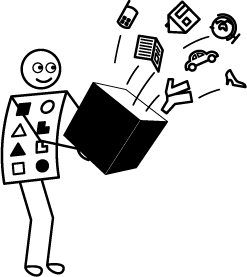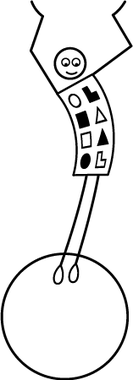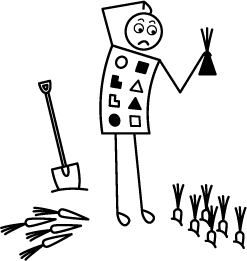Information elements. Subjective perception
Let us look closer at the information we receive. What kind of information is it? What is it about? We perceive, for instance, that a cucumber is green; that someone is angry; that it is already (or only?) 2 p.m.; that oil prices grow and, therefore, the petrol price grows as well; that 2+2=4; that we have become sad or we are hungry; that it’s hot today; that we must use a hammer in order to drive a nail; that there are systems and models… and so on. The problem of information complexity can be simplified by categorizing these separate information pieces.
In socionics, all the information is divided into eight information elements. They are called «work», «system», «will», «comfort», «emotions», «relationship», «possibilities», «events». It needs to be emphasized that these names are just technical terms. They are not quite fortunate, alas, but they have become common terms in the language of socionics. Let us consider their exact sense.
At first, the following question arises: how was all the information categorized (or subdivided) into these 8 information elements? Why was it done in this way? Can these eight categories cover all the possible kinds of information? Before we turn to this question, it is worthwhile to make a brief digression on the problem related to subjectivity of our perception. Scientists widely agree that human perception is subjective. What does this mean? The Great Encyclopaedic Dictionary gives the following definition of the term «subjective»:
Subjective
1) belonging to or related to the mind of the thinking subject or resulting from activity of the latter;
2) characteristic of knowledge meaning that the nature of the object being considered is not described comprehensively.
Hence, our perception is not thorough enough, we perceive only in the way our sense organs enable us to. Let us try to imagine a way in which a frog (or a snake) see a fly? It could be totally different from our way of seeing. It is known that some animals are able to hear (or feel) ultrasound, which it beyond our hearing, or some can see only moving objects. Some animals, unlike humans, can «see» heat radiated by bodies. From this perspective, our (human) perception is somehow limited. For instance, we know about solar radiation and, though we heard physicists talk about electromagnetic waves, we can perceive them only as heat and light. Consequently, our reasoning will be devoted to subjective perception, and it is the information perceived subjectively that will be subdivided into the informational elements.
Let us consider the process of dividing all the information according to certain properties. We live in a material world, as we perceive it. In this world we can distinguish the substance that is solid and the field that we cannot touch. We can also see that the substance exists in the form of separate items; for example, stones, trees, sand, water, etc. What makes them separate? Since any object ends somewhere, it is boundaries of objects that do the job. Hence, we can subdivide the substance into objects and space between them. Moreover, any object has its own properties.
What about field? The Collins Dictionary gives the following definition of this word:
Field is a the region of space surrounding a body, such as a charged particle or a magnet, within which it can exert a force on another similar body not in contact with it.
We perceive the action of these forces as some energy.
Thus, we have objects in a space where some forces act (and we feel energy, as a result). But objects, space, and energy change constantly. We perceive these changes as flow of time, or events. A seed grows into a sprout, then the trunk appears and branches follow. Little by little, a tree grows. For the man, these changes are appropriately fixed as flow of time, a sequence of events in time.
We have already defined the four information macroelements: «objects», «space», «energy», and «time». They envelop all the information that a person can receive. In socionics, the information macroelements are denoted by the following symbols:  ,
,  ,
,  ,
,  . Please, note that the symbols are two-colored. But we should obtain eight information elements now. Let us subdivide each macroelement into two components as follows:
. Please, note that the symbols are two-colored. But we should obtain eight information elements now. Let us subdivide each macroelement into two components as follows:
1. The essence component is fundamental, essential properties of an object that single out it among other objects.
2. The relation component is relations between essential properties, comparison of essential properties with each other.
Let us illustrate these components by deriving information about such a usual object as a table. A table is often wooden, right-angled; it has legs supporting the table top. The basic feature of any table is its horizontal surface resting on something since we use tables to put something on (for instance, a meal), to write, to eat, to work or to do anything else. In this example we have considered essential properties of the table, i.e., fundamental features that basically define any table.
People invented a large variety of tables: writing-tables, coffee tables, kitchen and other ones. There are tables with one, two, three, or four legs. Tables are parts of furniture sets: for example, a coffee table and to chairs; or a wardrobe, a sofa, armchairs, a dining-table, and chairs. Tables can be made of wood, glass, plastic, some metal, etc. When we consider the variety of tables and their types, we compare them with each other, create relations in mind. As seen from the example, relations of objects are needed for some classifying and systematizing purposes, for arranging and generalizing our knowledge.
Thus, the information macroelement «objects» ( ) is subdivided into two information elements: «work» (
) is subdivided into two information elements: «work» ( ) and «system» (
) and «system» ( ) (the symbols are now single-colored). We have given such names to these information elements because by using objects’ properties (their essence), we do some work (on objects or by means of them). Let us take wood, for example. This material is soft enough (though not so soft as fluff), but it is softer than a metal. Therefore, we can tool it by some harder sharp metal instrument such as a knife, a saw, or an axe. Since wood doesn’t sink, we can build a raft out of it. Since wood burns, we can use it as fuel. Working with objects, a man creates technologies, methods, procedures, manufacture process.
) (the symbols are now single-colored). We have given such names to these information elements because by using objects’ properties (their essence), we do some work (on objects or by means of them). Let us take wood, for example. This material is soft enough (though not so soft as fluff), but it is softer than a metal. Therefore, we can tool it by some harder sharp metal instrument such as a knife, a saw, or an axe. Since wood doesn’t sink, we can build a raft out of it. Since wood burns, we can use it as fuel. Working with objects, a man creates technologies, methods, procedures, manufacture process.
the information element «work» is also called «practical logic», «black logic»
In socionics, the information element «work» is also called «practical logic», «black logic» (according to the color of its symbol  ).
).
 It should be noted that, whenever we hear the word «work», it is not necessarily the context of the «work logic». When someone writes a program, serves clients, sings on the stage, or creates a book, he or she works as well, but this activity is nor a work on objects neither by means of them. Therefore, we should be attentive and remember that «work logic» relates only to objects and their properties.
It should be noted that, whenever we hear the word «work», it is not necessarily the context of the «work logic». When someone writes a program, serves clients, sings on the stage, or creates a book, he or she works as well, but this activity is nor a work on objects neither by means of them. Therefore, we should be attentive and remember that «work logic» relates only to objects and their properties.
Comparison of objects' properties and relations between them, constitues major part logical information called systematizing. Finding out general properties and differences; creating tables, schemes, and structures; math computations, arranging in certain order, or constructing of algorithms; finding out dependencies and regularities; constructing of hierarchies and classifications; making statistical calculations, etc can be generally attributed to the notion of logical operations.
Let us do some arithmetics. How much is it if two chairs are added to another three chairs? Obviously that makes five chairs. Were we interested in features of that chairs (material, upholstery, etc.) when counting them? No, we were interested only in quantity, i.e., in a certin co-relation between the objects. We can further disembody them in our mind and count abstractly: 2+3=5. This is an illustartion of what the system logic means.
The informational element «system» is also called «structural logic», «white logic»
The informational element «system» is also called «structural logic», «white logic» (once again, according to the color of its symbol  ).
).
Let us now subdivide the remaining macroelements in the same way.
«force» ( or «volitional sensing», «black sensing»)
The informational macroelement «space» ( ) consists of the essence component «force» («volitional sensing», «black sensing»
) consists of the essence component «force» («volitional sensing», «black sensing»  ) and the relation component «comfort» («experiential sensing», «white sensing»
) and the relation component «comfort» («experiential sensing», «white sensing»  ).
).
«comfort» (or «experitntial sensing», «white sensing»)
We remember that macroelements are divided according to their essence component and the relation component. Subjectively, we perceive space as emptiness between objects that is formed by their boundaries. Space would not exist in our perception without boundaries. The measurable space and extent of «empty» space and the notion of objects appear as soon as boundaries appear. Any bound is a force barrier, since we need to apply some force to set boundaries or to change them, hense «will sensing» is related to force. Thus, the essential feature of space is the presence of bounded extent.
We can consider not only physical but also psychological space. You’ve possibly heard the expression «life space». We can broaden, defend, enrich, make larger or smaller, or protect all these spaces. When you buy something for yourself, your home, or family, as well as earn money, you thereby are strengthening your life space.
The vocabulary of this information element is following: defense, attack, space limitation, pressure, to strike, to kill, to repulse, will, influence, compulsion, discipline, firmness, power, authority, mobilization, aggression.
 Information on relations between boundaries constitutes the informational element «comfort». Indeed, let us remenver our sensations while wearing new shoes. For example, we could say: «They are too tight and uncomfortable». How have do you know if they are comfortable or not? You have sensed the co-relation between boundaries of your feet and the inner space of the shoes. This relation has brought to you the required information on comfort. The same thing happens when you sit on a chair or an armchair. You sense how boundaries of your body and the chair touch each other. And you get to know if this chair (or a dress, or a room) is comfortable or not.
Information on relations between boundaries constitutes the informational element «comfort». Indeed, let us remenver our sensations while wearing new shoes. For example, we could say: «They are too tight and uncomfortable». How have do you know if they are comfortable or not? You have sensed the co-relation between boundaries of your feet and the inner space of the shoes. This relation has brought to you the required information on comfort. The same thing happens when you sit on a chair or an armchair. You sense how boundaries of your body and the chair touch each other. And you get to know if this chair (or a dress, or a room) is comfortable or not.
Another example regarding this kind of information is the notion of harmony of lines. You see a vase posessing elegant lines and proportions and exclaim: «How beautiful!» Beauty is perceived as relation between boundaries, hence it is also attributed to «comfort sensing». But note, that if we understand beauty as emotional admiration, or if we call beautiful an expensive status object or a relationship, or even a math formula, then we should understand that in this case it means another information element. Such ambiguous words are called multi-elemental. Their attribution to a certain information element depends on the context and on the implied meaning. The word «money», which we usually encounter in the context of «black sensing», is also multi-elemental.
«emotions» («emotive ethics», «black ethics»)
Let us consider further subdivision of the «energy» macroelement ( ). As usual, it is subdivided into the essence component «emotions» («emotive ethics», «black ethics»
). As usual, it is subdivided into the essence component «emotions» («emotive ethics», «black ethics»  ) and the relation component — «relationship» («relational ethics», «white ethics»
) and the relation component — «relationship» («relational ethics», «white ethics»  ). But what is in common between energy, emotions, relationship? In fact, if your emotional state changes, it follows the change in your energy state. If you are happy, then your energy state is high, and it feels like you have a lot of power and are ready to sing, jump, or uproot the trees. But if your mood becomes worse, it feels like colors fade, power leaves you and makes place for apathy, and you want to do nothing — all due to the change of your energy state. Therefore, the essence of the informational macroelement «energy» is our inner emotional state, or «emotions»: passion, joy, melancholy, panic, excitement, enthusiasm, drama, moods, depression, inspiration, scare, anxiety, sorrow, grief, laugh, cry, love (as an energy state), etc.
). But what is in common between energy, emotions, relationship? In fact, if your emotional state changes, it follows the change in your energy state. If you are happy, then your energy state is high, and it feels like you have a lot of power and are ready to sing, jump, or uproot the trees. But if your mood becomes worse, it feels like colors fade, power leaves you and makes place for apathy, and you want to do nothing — all due to the change of your energy state. Therefore, the essence of the informational macroelement «energy» is our inner emotional state, or «emotions»: passion, joy, melancholy, panic, excitement, enthusiasm, drama, moods, depression, inspiration, scare, anxiety, sorrow, grief, laugh, cry, love (as an energy state), etc. 
«Relationships» are relations between energy states. If you meet a person who tells you something rude, your emotional state changes, you conceive a special relationship for this person. We can say that the comparison of two energy states has served to create a certain relation. Relationship is directed to something or someone; to have a relationship you need another object, i.e., the object of the relationship.
«relationship» («relational ethics», «white ethics»)
The «relationships» element can be described by the following terms: good, kind, evil, delicate, polite, tolerant, quarrelsome, sympathy, antipathy, cruel, bad, hatred, conflict, offence, love (as a relationship), etc.
«possibilities» («potentiality intuition», «black intuition»)
The informational macroelement «time» ( ) is subdivided into the essence component «possibilities» («potentiality intuition», «black intuition»
) is subdivided into the essence component «possibilities» («potentiality intuition», «black intuition»  ) and the relational component «events» («temporal intuition», «white intuition»
) and the relational component «events» («temporal intuition», «white intuition»  ).
).
 Let us imagine that we are standing somewhere in an open place. We have a lot of possibilities to turn around ourselves at any angle up to 360° and make a step. But all these possibilities are potential and not yet realised. From the variety, we can choose only one possibility and make that step. And this undertaken step will crate a realised possibility, i.e., an event. This illustration is very simple, however at any moment in our lives we indeed have an immence choice of options. The exact development of further events depends on the choices we make. Thus, a possibility is a potential event, and it constitutes the essence of «time» macroelement. Possibility intuition is related to such notions as insight, positive (negative) potential, abilities, essence, ideas, originality, uncommon, interest, fabulous, good and bad variants, possibilities, positive and negative traits, «the other side of the coin», lack of prospects, meaninglessness, mediocrity.
Let us imagine that we are standing somewhere in an open place. We have a lot of possibilities to turn around ourselves at any angle up to 360° and make a step. But all these possibilities are potential and not yet realised. From the variety, we can choose only one possibility and make that step. And this undertaken step will crate a realised possibility, i.e., an event. This illustration is very simple, however at any moment in our lives we indeed have an immence choice of options. The exact development of further events depends on the choices we make. Thus, a possibility is a potential event, and it constitutes the essence of «time» macroelement. Possibility intuition is related to such notions as insight, positive (negative) potential, abilities, essence, ideas, originality, uncommon, interest, fabulous, good and bad variants, possibilities, positive and negative traits, «the other side of the coin», lack of prospects, meaninglessness, mediocrity.
Instead, it is an accomplished event that will be registereg on the timeline. It determines the developments of history. We subjectively perceive sequential events as flow of time.  Not only something grand and historical is considered to be an event, but any realised possibility or change: a pen which fell from a table is also an event. Flow of time can be described only in terms of events or happenigs. Try to write an essay about how you have spent your day, and you will see that you are writing about what has happened during the day. The man perceives time through events, i.e., realised possibilities. Therefore, co-relations between possibilities as they are realised is translated into events, or changes in time. Time intuition is assosiated with such notions as: perspective, events, changes, forsight, prediction, being late, delay, waste of time, cavalcade of history, fortune, etc.
Not only something grand and historical is considered to be an event, but any realised possibility or change: a pen which fell from a table is also an event. Flow of time can be described only in terms of events or happenigs. Try to write an essay about how you have spent your day, and you will see that you are writing about what has happened during the day. The man perceives time through events, i.e., realised possibilities. Therefore, co-relations between possibilities as they are realised is translated into events, or changes in time. Time intuition is assosiated with such notions as: perspective, events, changes, forsight, prediction, being late, delay, waste of time, cavalcade of history, fortune, etc.
An important remark should be done here. Terms used in socionics are often confused with the common language notions and meanings. The word «intuition» is often understood as getting some information by insight. Of course, we can grasp some possibilities or predict some events in this way, but describing a way or mode of getting information does not always correcpond with the "possibility intuition" in socionics. Perhaps, intuits generally have a more developed channel for getting insight knowledge, but this topic has not yet been investigated. Therefore, it is incorrect to immediately label all people who have had insights or who have seen prophetic dreams and «signs» as intuits. All people have insight to some extent, however 'intuitive' TIMs must be identified by means of other tools, that will be discussed later.
As noted above, many words in a real language are multi-elemental, and ascribing a word to a certain information element is possible only based on the context. How should we procced in order to find the underlying information element correctly? For instance, the term «comfort» may relate to different informational elements according to the context. Let us consider the following sentence:
If our affections be tried, our affections are our consolation and comfort.
Here the word «comfort» is used to describe an emotional state; thus, it corresponds to «the emotion ethics»  . Let us compare it with the following one:
. Let us compare it with the following one:
The sofa was already moved into a warm corner for her greater comfort.
Here the same word describes a certain sensation and, thus, should be related to «the comfort sensing»  .
.
Another example of a multi-elemental word is «money». Let us compare two sentences:
Money is a means of enrichment.
Money is stamped paper notes of certain value.
In order to make analysis of information elements, make a step back. The first sentence alludes to the notion of extending one's life space; thus, it must be «will sensing»  . While the second sentence is talking about a material object and its qualities, thus it is about «work logic»
. While the second sentence is talking about a material object and its qualities, thus it is about «work logic»  .
.
We have considered all the information elements which humans perceive while interacting with the world. Below you can find the reference of widely used socionical terms and desicnations of the information elements.
Information elements
| P | «work», «practical logic», «black logic» |
|
| L | «system», «structural logic», «white logic» |
|
| F | «will», «volitional sensing», «black sensing» |
|
| S | «comfort», «experiential sensing», «white sensing» |
|
| Е | «emotions», «emotive ethics», «black ethics» |
|
| R | «relationship», «relational ethics», «white ethics» |
|
| I | «possibilities», «potentiality intuition», «black intuition» |
|
| Т | «events», «temporal intuition», «white intuition» |
|
Later on we will focus on how the man gets all that information, processes it, and gives back the output. It will be done by building a model of interaction between the man and the world.
Eglit IM ©